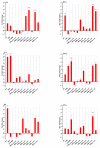Impact of Individual Viral Gene Segments from Influenza A/H5N8 Virus on the Protective Efficacy of Inactivated Subtype-Specific Influenza Vaccine
- PMID: 33808583
- PMCID: PMC8003407
- DOI: 10.3390/pathogens10030368
Impact of Individual Viral Gene Segments from Influenza A/H5N8 Virus on the Protective Efficacy of Inactivated Subtype-Specific Influenza Vaccine
Abstract
Since its emergence in 2014, the highly pathogenic avian influenza H5N8 virus has continuously and rapidly spread worldwide in the poultry sector resulting in huge economic losses. A typical inactivated H5N8 vaccine is prepared using the six internal genes from A/PR8/1934 (H1N1) and the two major antigenic proteins (HA and NA) from the circulating H5N8 strain with the HA modified to a low pathogenic form (PR8HA/NA-H5N8). The contribution of the other internal proteins from H5N8, either individually or in combination, to the overall protective efficacy of PR8-based H5N8 vaccine has not been investigated. Using reverse genetics, a set of PR8-based vaccines expressing the individual proteins from an H5N8 strain were rescued and compared to the parent PR8 and low pathogenic H5N8 strains and the commonly used PR8HA/NA-H5N8. Except for the PR8-based vaccine strains expressing the HA of H5N8, none of the rescued combinations could efficiently elicit virus-neutralizing antibodies. Compared to PR8, the non-HA viral proteins provided some protection to infected chickens six days post infection. We assume that this late protection was related to cell-based immunity rather than antibody-mediated immunity. This may explain the slight advantage of using full low pathogenic H5N8 instead of PR8HA/NA-H5N8 to improve protection by both the innate and the humoral arms of the immune system.
Keywords: H5N8; PR8-based influenza vaccine; humoral immunity; innate immunity; vaccine efficacy.
Conflict of interest statement
The authors declare no conflict of interest.
Figures





Similar articles
-
Bioengineering a highly productive vaccine strain in embryonated chicken eggs and mammals from a non-pathogenic clade 2·3·4·4 H5N8 strain.Vaccine. 2019 Sep 30;37(42):6154-6161. doi: 10.1016/j.vaccine.2019.08.074. Epub 2019 Sep 5. Vaccine. 2019. PMID: 31495597
-
Vaccine Efficacy of Inactivated, Chimeric Hemagglutinin H9/H5N2 Avian Influenza Virus and Its Suitability for the Marker Vaccine Strategy.J Virol. 2017 Feb 28;91(6):e01693-16. doi: 10.1128/JVI.01693-16. Print 2017 Mar 15. J Virol. 2017. PMID: 28077631 Free PMC article.
-
Development and comparison of two H5N8 influenza A vaccine candidate strains.Arch Virol. 2019 Jan;164(1):127-136. doi: 10.1007/s00705-018-4062-9. Epub 2018 Oct 5. Arch Virol. 2019. PMID: 30291503
-
Protection Afforded by a Recombinant Turkey Herpesvirus-H5 Vaccine Against the 2014 European Highly Pathogenic H5N8 Avian Influenza Strain.Avian Dis. 2016 May;60(1 Suppl):202-9. doi: 10.1637/11126-050615-Reg.1. Avian Dis. 2016. PMID: 27309056
-
Development and application of avian influenza vaccines in China.Curr Top Microbiol Immunol. 2009;333:153-62. doi: 10.1007/978-3-540-92165-3_7. Curr Top Microbiol Immunol. 2009. PMID: 19768404 Review.
Cited by
-
AddaVax-Adjuvanted H5N8 Inactivated Vaccine Induces Robust Humoral Immune Response against Different Clades of H5 Viruses.Vaccines (Basel). 2022 Oct 9;10(10):1683. doi: 10.3390/vaccines10101683. Vaccines (Basel). 2022. PMID: 36298548 Free PMC article.
References
Grants and funding
LinkOut - more resources
Full Text Sources
Other Literature Sources

